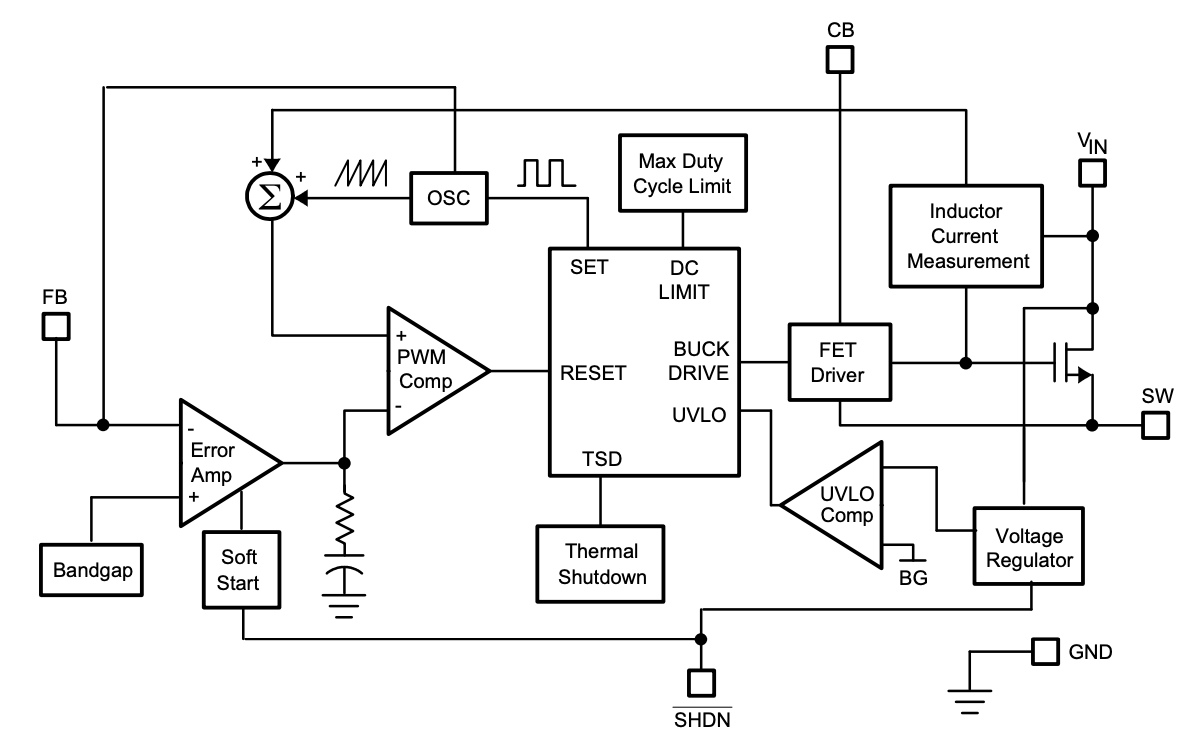Composable Electronics
How do we make designing electronics more like playing with legos? We need to standardize the building blocks, how they can be connected together and publish 'instruction manuals' that describe how to connect them up to make something useful.
The blocks
How do you describe what a component is? Today we rely on a language description in a datasheet and a clever human to interpret it. The information is not easily interpretable by a computer, which makes it hard to automate or augment the design process.
We need a way to embed key information into the source files.
What are the functional blocks inside the chip?
Here is a simple example of a buck converter IC.
 Lets try simplify this into a few functional blocks. Lets say the 'controller' is a block that takes in a voltage outputs a switching node, with a feedback pin. We can just use a NFET component for the fet. So in ato code we could define this as:
Lets try simplify this into a few functional blocks. Lets say the 'controller' is a block that takes in a voltage outputs a switching node, with a feedback pin. We can just use a NFET component for the fet. So in ato code we could define this as:
Connecting and configuring the blocks
To more completely describe the internals of the IC, we need to define how the blocks are connected and what their properties are. Below we are connecting the NFET to the controller, connecting the blocks to the outputs and configuring the voltage and current limits.
# connect blocks to pins
controller.feedback ~ fb
controller.power_in.vcc ~ vin
controller.power_out.gnd ~ gnd
nfet.drain ~ sw
The Instruction Manual
Following through with our buck converter example, lets build a description of how to connect the blocks together to make a buck converter.

To start, lets make a new 'topology' and instantiate the required blocks.
topology Buck:
# Define external interfaces
power_in = new Power
power_out = new Power
# Define blocks
inductor = new Inductor
output_cap = new Capacitor
input_cap = new Capacitor
diode = new Diode
controller = new BuckController
nfet = new NFET
feedback_divider = new VDiv
Next, lets connect the blocks together.
# Connect internal components
controller.drive ~ nfet.gate
# Method to chain dipole components (feedback welcome)
power_in.vcc ~ nfet ~ inductor ~ power_out.vcc
diode.anode ~ gnd
diode.cathode ~ inductor.1
# Feedback divider (input is a power interface)
feedback_divider.input ~ power_out
feedback_divider.output ~ controller.feedback
# Connect bypass capacitors
power_in ~ input_cap
power_out ~ output_cap
# We might want to define some equations to make the buck more intuitive to use
eqn: power_out.voltage = feedback_divider.input.voltage
eqn: controller.feedback.voltage = feedback_divider.output.voltage
Finally, we need a way to relate the two. Let now create a specific instance of the topology and define the parameters.
buck = new Buck
ic = new LM2841
# Map the IC to the topology using the replacement operator
buck.controller -> ic.controller
buck.nfet -> ic.nfet
# Configure the buck components
buck.inductor.inductance = 10uH +/- 20%
input_cap.capacitance = 10uF +/- 20%
output_cap.capacitance = 10uF +/- 20%
# Configure output voltage
buck.power_out.voltage = 5V +/- 5%
That might all feel like alot of work, until you realize that the topologies and components are reusable and only need to be defined once. You can design a buck converter using just that last block of code and a few imports.
If you are interested in checking out the full example, you can find it here
We have a few language features in the pipeline that will enable this type of workflow in the near future.
Narayan